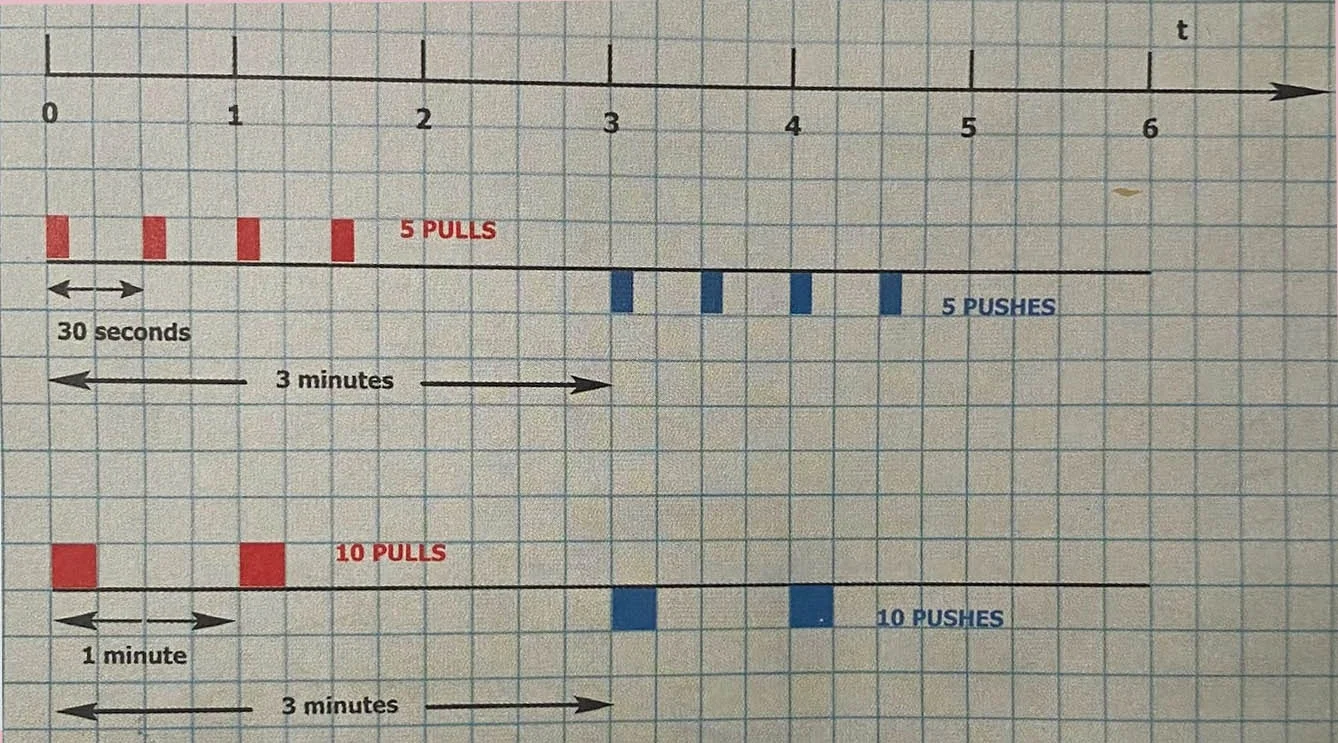Minimalist Training Plans
The Novice
Defined as someone who has not ever really done any resistance training since P.E. class in high school.
Equipment: You’ll need an 8kg or a 18lb kettlebell which if you don’t have you can purchase online or locally. When it becomes easy (usually after 8 weeks of consistency), you’ll need a 12kg or 25 lb bell. Once the 12kg bell is easy (after 16 weeks), you’ll aim over time to swing a 16 kg bell. Within a year you could swing a 24 kg bell (53lbs) with some ease.
You’ll practice 2 moves: The two-handed kettlebell swing & deadbugs
For an in-depth description of the kettlebell swing read here.
Warm up: Squat and in a “prayer position” use your elbows as if to “pry your hips out of their sockets” (60 seconds).
- Do 360 degree slow hip circles as if hula-hooping (60 seconds)
- Find something solid to grab with both hands behind you (pole, door frame, whatever you can grip) and bend forward opening the chest and shoulders (hold 30-60 seconds)
Repetitions and sets: Do 10 sets of 10 swings resting in between each set until your breathing is normal and relaxed. Do 5 sets of 10 deadbugs (5 per leg) resting in between each set until your breathing is normal and relaxed.
Training Frequency: Depending on your current life and schedule do no less than 2 sessions per week, and no more than 4 sessions per week. Choose the pattern that suits you best below. Book appointments with yourself.
- 2 sessions per week: Either Mon/Thurs or Wed/Sat or Thurs/Sun
- 3 sessions per week: M/W/F or T/Th/S or W/Fr/Su
- 4 sessions per week: M/W/F/Sa or T/Th/Sa/Su
Notes: The purpose of any training is to feel like it energizes you for your life. You should feel accomplished, not completely spent after training and the day after for the first few weeks your muscles will “talk” to you and “complain” a little but any soreness should not be extreme. If it is, pull back on training day frequency. Your body will adapt over time.
Experienced
Defined as someone who has weight trained in the past, but has maybe been out of practice but knows how to move in a variety of ways with the 4 basic movement patterns: push, pull, squat, hinge. Also they have access to a variety of equipment including dumbbells, kettlebells, bands,
Equipment: Kettlebell or Dumbbell
Moves: Kettlebell swing and Get-up (to learn the get-up and practice balance try your shoe). Master your shoe before you do weight. Practice these movements for safety first with any load.
For an in-depth description of the kettlebell swing read here.
Repetitions and sets: Do 10 sets of 10 swings resting in between each set until your breathing is normal and relaxed. Do 5 get ups per side, the slower the better, resting in between each set until your breathing is normal and relaxed.
Training Frequency: Depending on your current life and schedule do no less than 2 sessions per week, and no more than 4 sessions per week. Choose the pattern that suits you best below. Book appointments with yourself.
2 sessions per week: Either Mon/Thurs or Wed/Sat or Thurs/Sun
3 sessions per week: M/W/F or T/Th/S or W/Fr/Su
4 sessions per week: M/W/F/Sa or T/Th/Sa/Su
Advanced
This training is aimed at developing power, while minimizing fatigue and soreness, leaving plenty of time and energy for the busy lives of moms, dads, professionals & executives. This is for well-trained people who have a sufficient amount of strength and power developed.
Equipment: Kettlebell preferred; can also be a dumbbell
Moves: Kettlebell swing (two-handed & one-handed), push ups
When to train: 2 or 3 times a week with rest days in between; train fresh
- The best time depends on the outcome you want to achieve
- For power train in the early evening but not too close to bedtime
- For health/endurance, train FASTED in the morning
Warm ups:
- squat and in a “prayer position” use your elbows as if to “pry your hips out of their sockets” (60 seconds).
- Do 360 degree slow hip circles as if hula-hooping (60 seconds)
- Find something solid to grab with both hands behind you (pole, door frame, whatever you can grip) and bend forward opening the chest and shoulders (hold 30-60 seconds)
Structure: Always alternate between “pulls” (swings) and pushes (push ups).
- There are always 20 reps in a set, made up of either five reps (4 sets) or 10 reps (2 sets). In 1-arm swings, switch arms from set to set: 5L, 5R, 5L, 5R…or 10L, 10R
- Rest between sets by walking around and shaking your arms out.
- 5 reps every 30 seconds (5 reps in ~ 10 seconds, rest for 20)
- 10 reps every 60 seconds (10 resp in ~ 20 seconds, rest for 40)
- If it helps you can get a basic Tabata Timer app free online to help create the right time parameters.
- Take a full 60 seconds rest after you complete 20 reps in any given set. Do not compress rest periods. If you think it’s too easy, increase the intensity of your movement or use a heavier weight.
Load and Volume:
- Use a die to determine your variables for a given day. Always start with swings.
- If you’re having an “off day” on a training day don’t roll a die, do two series of 40 reps for each lift (see below).
|
Die shows |
1 |
2 |
3 |
4 |
5 |
6 |
|
Total reps |
40 |
60 |
80 |
100 |
||
|
# of Series |
2 |
3 |
4 |
5 |
||
|
Session Length |
12 min |
18 min |
24 min |
30 min |
||
|
If you rolled the same rep count as the last session, roll again |
||||||
REST: Remember to do the rests as prescribed and don’t compress rest periods.
Example shown for 20 total reps, 1 series…(see above under dice shows ‘1’)

